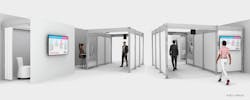This article originally appeared in the September 2020 issue of Security Business magazine. When sharing, don’t forget to mention @SecBusinessMag on Twitter and Security Business magazine on LinkedIn.
Much like everybody else throughout the COVID-19 pandemic, the staff at the National Systems Contractors Association (NSCA) has been on the phone a lot. In our case, we have been talking to integration firm leaders about how to run a company during these turbulent times – and, in too many cases, how to stay in business.
We have also been listening. The individuals who run integration companies are under tremendous pressure. Their circumstances vary depending on geographic area, customer bases and solution sets; however, one sentiment is unanimous among security integration company leaders: Their businesses will never be quite the same.
That is obviously highly influenced by factors related to COVID-19, but it is also a reflection of an ever-changing security integration market. Security integration companies, with their backs against the wall, are strategizing to position themselves for sustained success. Indeed, security integration is changing. Here are 11 examples of the security integrator’s evolving role, along with strategies to adapt:
1. Increased Emphasis on Cybersecurity: The security integration industry’s cyber-posture needs to improve – both security integration companies’ internal operations and for their customers. Companies need to better consider what they do in their own shops in terms of protecting equipment, databases and files. To be the security integrators of the future, we have to get our own houses in order. Then we need to make sure to be cyber-savvy on the client end because of all the IP-enabled devices.
This will require an investment in cyber positioning, including training and hiring individuals with cybersecurity credentials. Many NSCA member companies work with cybersecurity platform provider Defendify (http://defendify.io), which also provides companies with cybersecurity consulting and resources.
2. Transition to an OPEX Model: Security-as-a-service or life-safety-as-a-service – via monthly payment – will make sense for many customers working from an operating expense (OPEX) vs. a capital expense (CAPEX) model going forward. Testing and inspection already fall under this model, but we expect the project itself to follow. This change is driven by the cloud and off-premises solutions.
Customer companies are also focused on cash preservation, so shelling out a lot of upfront capital for a project makes less sense. Meanwhile, the uncertainty around the market (and the world) equates to customers not always knowing what types of solutions they need. An OPEX scenario is more palatable because they get some assurance of quality, ongoing maintenance and upgrades.
3. Licensing and Regulations: Security integration firms should be more mindful of the need for licensure and regulatory compliances. A growing number of states are creating regulations with license provisions around Power-over-Ethernet (PoE) systems. As we all know, many security and life safety devices are PoE enabled. These are potentially business-crushing developments that security integration company leaders need to follow.
NSCA encourages members to track state and federal legislative activity via the advocacy section of our website (www.nsca.org/track-legislation). We strongly recommend that integration firm leaders join with us in pushing back against proposed business-limiting regulations.4. Navigating Jobsite Logistics: Any post-COVID-19 reboot plan should include new policies and project management processes for jobsite health and safety precautions. Integration companies need to invest in making sure that they can service a client's facility without having to go on site every time. This might include having a helpdesk and facilitating remote access to check the status of devices and monitor remotely.
5. The 20% Factor: The security integration market is, of course, facing challenges on the business side related to the impact of COVID-19. For the remainder of 2020, companies must figure out a way to operate at about 80% efficiency. Based on our data points, NSCA is predicting a 20% labor overage due, in part, to a need for personal protection equipment and new job site access rules.
If you bid 100 hours to do a project, keep in mind that it is probably going to take you 120 hours due to new COVID-related factors, such as cleaning.
6. Cloud and IoT: It is not just that so many security and life safety solutions are shifting to the cloud; it is the impact of that shift. The security integration industry can dramatically increase the importance of what it does through cloud-based security technology. Not only can integrators secure the customer’s facility, they can also help improve their COVID-19 procedures.
Customers are extremely focused on capacity and occupancy monitoring. Integrators can help customers track people by using sensor technology to ensure people are only where they need to be. By monitoring temperature and humidity, buildings can be optimized for their capacities. The shift to Internet of Things (IoT) sensor-based technologies is also an important shift where integrators can help.7. Health Check Solutions: The definition of “security” is evolving, and in a post-COVID-19 world, health monitoring will help keep customers safe. Security integration companies should consider providing solutions for office entrance health monitoring.
NSCA integration company member Red Thread, for example, has launched its own solution – RapidEntry – which screens people’s temperatures as they enter a building by leveraging a thermal camera with calibrator technology.
NSCA 2020 Pivot to Profit sponsor AMETEK Land (Land Instruments), offers the VIRALERT solution to identify potential coronavirus carriers by screening visitors for elevated temperatures.
8. Facial Recognition, AI and More: Much like security integration companies will soon become IoT providers in some way because sensors are so important in a post-COVID-19 workspace, facial recognition, artificial intelligence and machine learning will also play a vital role. Integration customers will use surveillance and access control equipment as data points to give them information about occupancy and capacities.9. Redefining Monitoring: While security integrators will continue to monitor occupied buildings, facilities that are no longer occupied due to COVID-19 concerns will play a role going forward. These spaces have potential for vandalism and break-ins. Security integrators will be forced to monitor spaces that have no security presence.
10. Acceptance: An emerging element to the security business is the battle between privacy and freedom. Consider a city with countless surveillance cameras. I see us, as a society, either fighting the fact that our every action is monitored or accepting it to provide better life safety.
As technology evolves, the level of societal acceptance should be constantly monitored by integration companies. The ongoing facial recognition technology debate is a good example.
11. Growing Need for Integrators: Security integration firm leaders should recognize that despite the many challenges posed by COVID, there are silver linings. In terms of security integration offerings being mission critical, it may have been a 5 on a 1-10 scale in the past; now it is has risen easily an 8 or 9.
The best thing integrators can do to keep revenue flowing is to understand a client’s business better to help keep their revenue flowing. Do this by applying technology solutions to make their facilities safer, better and more user-friendly.
Chuck Wilson is Executive Director of National Systems Contractors Association (NSCA) – http://NSCA.org. NSCA further explores the future of security integration business at its 2020 Pivot to Profit virtual conference. Learn more and register at http://nsca.org/p2p_2020.






